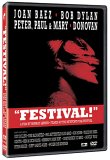| Reviews & Columns |
|
Reviews DVD TV on DVD Blu-ray 4K UHD International DVDs In Theaters Reviews by Studio Video Games Features Collector Series DVDs Easter Egg Database Interviews DVD Talk Radio Feature Articles Columns Anime Talk DVD Savant Horror DVDs The M.O.D. Squad Art House HD Talk Silent DVD
|
DVD Talk Forum |
|
|
| Resources |
|
DVD Price Search Customer Service #'s RCE Info Links |
|
Columns
|
|
|
Festival
But Festival should be remembered, if for no other reason than it captures dozens of live performances spanning several generations of music, including numerous and often great folk acts totally lost in today's Top 40, BMG/Tower Records/Virgin Megastore-driven world of mass market music.
Festival seamlessly blends footage shot at the Newport Folk Music Festival over four years, from 1963 through 1966. Director Murray Lerner (From Mao to Mozart: Isaac Stern in China ) mainly seems interested in soaking up the festivals' atmosphere, and in one terrific shot at the beginning, filmed with a long lens that flattens out the image, contemplates the throngs of folk fans swarming onto the festival grounds. (The IMDb seems to confuse Lerner with an indie producer from the late-1940/early-'50s. It's doubtful that Festival's Lerner is the same man who produced Rocketship-XM.) By the standards of the period they were as motley as the hippies flocking to Woodstock, what with their long hair (and, in some cases), long beards and goatees, though today most look positively clean-cut. Most of the men wear collared shirts and white pants, and are about as offensive as The Professor on Gilligan's Island.
At just 97 minutes, Festival offers mostly abbreviated performances, though always enough of each act so that its flavor and appeal becomes apparent. Some of the more famous names -- Bob Dylan, Judy Collins, Pete Seeger, Joan Baez, and especially Peter, Paul & Mary -- get a lot more coverage, but deservedly so, and it's interesting to note how much and/or how little each has changed over the intervening years. PP&M's Peter Yarrow, a trustee of the Newport Folk Music Festival, is often heard introducing acts, and is seen constantly checking sound levels, moving microphones around and the like. Joan Baez is clearly uncomfortable with her newfound popularity, while Dylan, obviously a star attraction and on the cusp of his folk-rock phase, has little of the interaction the other performers seem to enjoy with their fans. Donovan, Johnny Cash (looking high), and a briefly-glimpsed Ronnie Gilbert also perform.
The disparate styles of the period -- traditional Depression-era folk, folk-rock, protest songs, blues, etc. -- are given about equal coverage, but one senses this very diversity played a role in the genre's decline even while the film was being made. It's fascinating to watch Theodore Bikel and Mississippi John Hurt on the same stage, despite being musically at odds as much as Jimi Hendrix and Sha-Na-Na were in Woodstock. Certainly one of the real joys of Festival is watching acts less known to casual folk music fans, often with great names like Spider John Koerner and Fiddler Beers. The aforementioned Mississippi John Hurt (no relation, of course, to the respected British actor), Son House, and Fred McDowell are especially good.
Festival mostly avoids the pretentiousness often associated with folk protest songs (and the subject of constant ridicule on television and with stand-up comics) and instead is mostly a straightforward celebration of the music. "[Music] doesn't have to come out of a loudspeaker," Seeger says at one point, "[Folk is] music you can make yourselves." Indeed, there seem to be an equal number of guitars, banjos, and violins in the audience as on stage, where people play their own music and "swap songs" between acts. Preparing to perform "Mr. Tambourine Man," Bob Dylan asks his audience, "Does anyone have an E-harmonica? Just throw it up!" Several are immediately tossed onstage.
Video & Audio
Festival is presented here in its original full frame, black and white format. The image is very good for what it is, with strong blacks and a sharp image. (It's unclear whether this was shot in 35mm or blown-up from 16mm; in any case it looks very good.) The originally-mono film is presented here in both PCM Stereo and Dolby Digital 5.1, though the upgrade is barely noticeable, though the sound is always clear and pleasant. There are no subtitles, and the lack of chapter stops timed to each performance is disappointing. There are no Extra Features.
Parting Thoughts
Watching Festival I couldn't help but wonder if in a vault somewhere the complete performances of acts so abbreviated in the final cut might still exist. Not so much for Dylan or Baez, but for those lost-in-time acts ripe for rediscovery.
Stuart Galbraith IV is a Kyoto-based film historian whose work includes The Emperor and the Wolf - The Lives and Films of Akira Kurosawa and Toshiro Mifune and Taschen's forthcoming Cinema Nippon. Visit Stuart's Cine Blogarama here.
|
| Popular Reviews |
| Sponsored Links |
|
|
| Sponsored Links |
|
|
| Release List | Reviews | Shop | Newsletter | Forum | DVD Giveaways | Blu-Ray | Advertise |
|
Copyright 2024 DVDTalk.com All Rights Reserved. Legal Info, Privacy Policy, Terms of Use,
Manage Preferences,
Your Privacy Choices | |||||||














